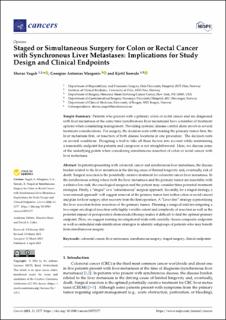| dc.contributor.author | Yakub, Sheraz | |
| dc.contributor.author | Margonis, Georgios Antonios | |
| dc.contributor.author | Søreide, Kjetil | |
| dc.date.accessioned | 2024-02-23T11:56:09Z | |
| dc.date.available | 2024-02-23T11:56:09Z | |
| dc.date.created | 2023-06-27T13:17:24Z | |
| dc.date.issued | 2023-04-06 | |
| dc.identifier.issn | 2072-6694 | |
| dc.identifier.uri | https://hdl.handle.net/11250/3119631 | |
| dc.description.abstract | In patients presenting with colorectal cancer and synchronous liver metastases, the disease burden related to the liver metastasis is the driving cause of limited longevity and, eventually, risk of death. Surgical resection is the potentially curative treatment for colorectal cancer liver metastases. In the synchronous setting where both the liver metastases and the primary tumor are resectable with a relative low risk, the oncological surgeon and the patient may consider three potential treatment strategies. Firstly, a “staged” or a “simultaneous” surgical approach. Secondly, for a staged strategy, a ‘conventional approach’ will suggest removal of the primary tumor first (either colon or rectal cancer) and plan for liver surgery after recovery from the first operation. A “Liver first” strategy is prioritizing the liver resection before resection of the primary tumor. Planning a surgical trial investigating a two-organ oncological resection with highly variable extent and complexity of resection as well as the potential impact of perioperative chemo(radio)therapy makes it difficult to find the optimal primary endpoint. Here, we suggest running investigational trials with carefully chosen composite endpoints as well as embedded risk-stratification strategies to identify subgroups of patients who may benefit from simultaneous surgery. | en_US |
| dc.language.iso | eng | en_US |
| dc.publisher | MDPI | en_US |
| dc.rights | Navngivelse 4.0 Internasjonal | * |
| dc.rights.uri | http://creativecommons.org/licenses/by/4.0/deed.no | * |
| dc.title | Staged or Simultaneous Surgery for Colon or Rectal Cancer with Synchronous Liver Metastases: Implications for Study Design and Clinical Endpoints | en_US |
| dc.type | Journal article | en_US |
| dc.type | Peer reviewed | en_US |
| dc.description.version | publishedVersion | en_US |
| dc.rights.holder | Copyright 2023 the authors | en_US |
| dc.source.articlenumber | 2177 | en_US |
| cristin.ispublished | true | |
| cristin.fulltext | original | |
| cristin.qualitycode | 1 | |
| dc.identifier.doi | 10.3390/cancers15072177 | |
| dc.identifier.cristin | 2158639 | |
| dc.source.journal | Cancers | en_US |
| dc.identifier.citation | Cancers. 2023, 15 (7), 2177. | en_US |
| dc.source.volume | 15 | en_US |
| dc.source.issue | 7 | en_US |

